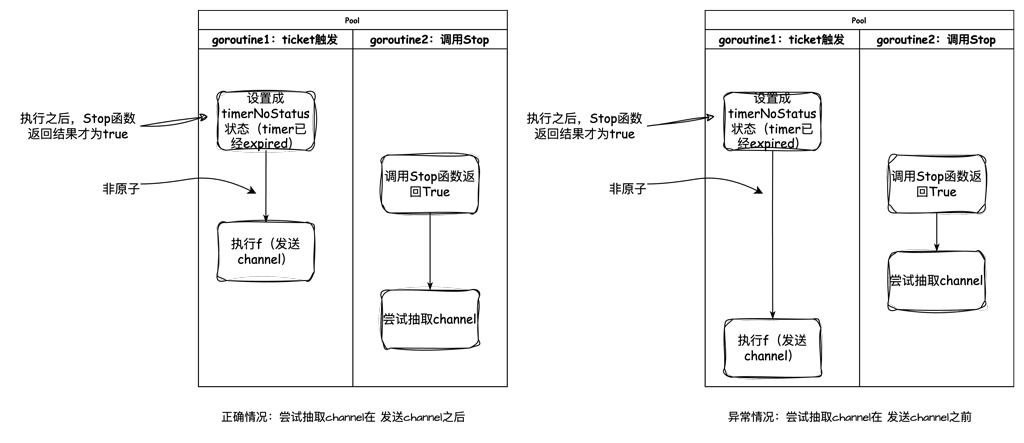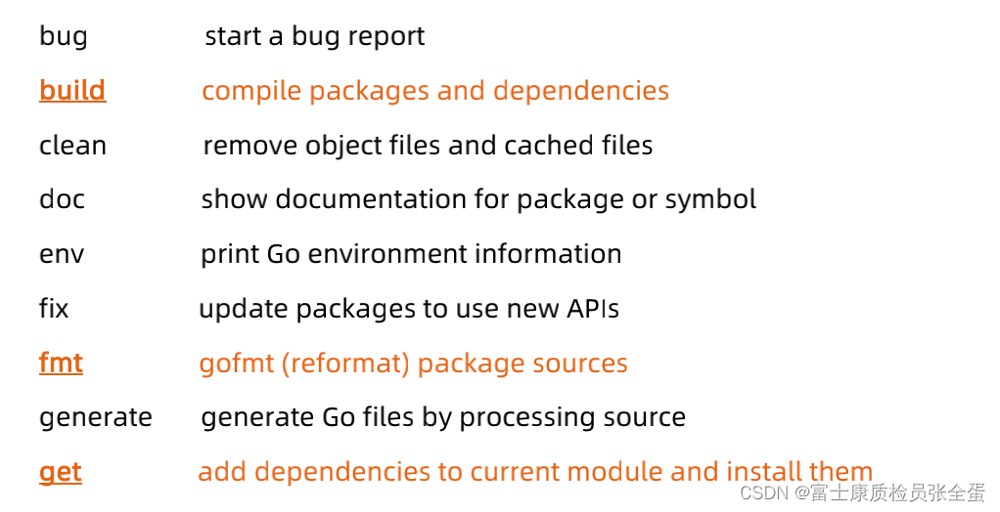golang 日志库ZAP[uber-go zap]
1. 简要说明
zap 是 uber 开源的 Go 高性能日志库,支持不同的日志级别, 能够打印基本信息等,但不支持日志的分割,这里我们可以使用 lumberjack 也是 zap 官方推荐用于日志分割,结合这两个库我们就可以实现以下功能的日志机制:
能够将事件记录到文件中,而不是应用程序控制台;日志切割能够根据文件大小、时间或间隔等来切割日志文件;支持不同的日志级别,例如 DEBUG , INFO , WARN , ERROR 等;能够打印基本信息,如调用文件、函数名和行号,日志时间等;官网地址:https://github.com/uber-go/zap
2. 下载安装
|
1 2 3 4 5 6 7 8 9 |
// 初始化go mod 通过mod管理扩展包 go mod init zaplog //使用下面命令安装 go get -u go.uber.org/zap //如果下载失败,则使用以下命令重新下载安装 go get github.com/uber-go/zap //下载安装成功后还有如下提示: package github.com/uber-go/zap: code in directory src/github.com/uber-go/zap expects import "go.uber.org/zap" |
3. 配置 zap Logger
zap 提供了两种类型的日志记录器—和 Logger 和 Sugared Logger 。两者之间的区别是:
- 在每一微秒和每一次内存分配都很重要的上下文中,使用Logger。它甚至比SugaredLogger更快,内存分配次数也更少,但它只支持强类型的结构化日志记录。
- 在性能很好但不是很关键的上下文中,使用SugaredLogger。它比其他结构化日志记录包快 4-10 倍,并且支持结构化和 printf 风格的日志记录。
- 所以一般场景下我们使用 Sugared Logger 就足够了。
3.1 Logger
- 通过调用zap.NewProduction()/zap.NewDevelopment()或者zap.NewExample()创建一个 Logger 。
- 上面的每一个函数都将创建一个 logger 。唯一的区别在于它将记录的信息不同。例如 production logger 默认记录调用函数信息、日期和时间等。
- 通过 Logger 调用 INFO 、 ERROR 等。
- 默认情况下日志都会打印到应用程序的 console 界面。
3.1.1 NewExample
|
1 2 3 4 5 6 7 8 9 10 11 12 13 14 15 16 17 18 19 20 21 22 23 |
//代码示例: package main import ( "go.uber.org/zap" ) func main() { log := zap.NewExample() log.Debug("this is debug message") log.Info("this is info message") log.Info("this is info message with fileds", zap.Int("age", 24), zap.String("agender", "man")) log.Warn("this is warn message") log.Error("this is error message") log.Panic("this is panic message") } //输出结果: {"level":"debug","msg":"this is debug message"} {"level":"info","msg":"this is info message"} {"level":"info","msg":"this is info message with fileds","age":24,"agender":"man"} {"level":"warn","msg":"this is warn message"} {"level":"error","msg":"this is error message"} {"level":"panic","msg":"this is panic message"} panic: this is panic message |
3.1.2 NewDevelopment
|
1 2 3 4 5 6 7 8 9 10 11 12 13 14 15 16 17 18 19 20 21 22 23 24 25 26 27 |
//代码示例: func main() { log, _ := zap.NewDevelopment() log.Debug("this is debug message") log.Info("this is info message") log.Info("this is info message with fileds", zap.Int("age", 24), zap.String("agender", "man")) log.Warn("this is warn message") log.Error("this is error message") // log.DPanic("This is a DPANIC message") // log.Panic("this is panic message") // log.Fatal("This is a FATAL message") } //输出结果: 2020-06-12T18:51:11.457+0800 DEBUG task/main.go:9 this is debug message 2020-06-12T18:51:11.457+0800 INFO task/main.go:10 this is info message 2020-06-12T18:51:11.457+0800 INFO task/main.go:11 this is info message with fileds {"age": 24, "agender": "man"} 2020-06-12T18:51:11.457+0800 WARN task/main.go:13 this is warn message main.main /home/wohu/GoCode/src/task/main.go:13 runtime.main /usr/local/go/src/runtime/proc.go:200 2020-06-12T18:51:11.457+0800 ERROR task/main.go:14 this is error message main.main /home/wohu/GoCode/src/task/main.go:14 runtime.main /usr/local/go/src/runtime/proc.go:200 |
3.1.3 NewProduction
|
1 2 3 4 5 6 7 8 9 10 11 12 13 14 15 16 17 18 |
代码示例: func main() { log, _ := zap.NewProduction() log.Debug("this is debug message") log.Info("this is info message") log.Info("this is info message with fileds", zap.Int("age", 24), zap.String("agender", "man")) log.Warn("this is warn message") log.Error("this is error message") // log.DPanic("This is a DPANIC message") // log.Panic("this is panic message") // log.Fatal("This is a FATAL message") } 输出结果: {"level":"info","ts":1591959367.316352,"caller":"task/main.go:10","msg":"this is info message"} {"level":"info","ts":1591959367.3163702,"caller":"task/main.go:11","msg":"this is info message with fileds","age":24,"agender":"man"} {"level":"warn","ts":1591959367.3163917,"caller":"task/main.go:13","msg":"this is warn message"} {"level":"error","ts":1591959367.3163974,"caller":"task/main.go:14","msg":"this is error message","stacktrace":"main.main\n\t/home/wohu/GoCode/src/task/main.go:14\nruntime.main\n\t/usr/local/go/src/runtime/proc.go:200"} |
3.1.4 对比总结
Example和Production使用的是 json 格式输出,Development 使用行的形式输出
- Development
- 从警告级别向上打印到堆栈中来跟踪
- 始终打印包/文件/行(方法)
- 在行尾添加任何额外字段作为 json 字符串
- 以大写形式打印级别名称
- 以毫秒为单位打印 ISO8601 格式的时间戳
- Production
- 调试级别消息不记录
- Error , Dpanic 级别的记录,会在堆栈中跟踪文件, Warn 不会
- 始终将调用者添加到文件中
- 以时间戳格式打印日期
- 以小写形式打印级别名称
- 在上面的代码中,我们首先创建了一个 Logger ,然后使用 Info / Error 等 Logger 方法记录消息。
日志记录器方法的语法是这样的:
|
1 |
func (log *Logger) MethodXXX(msg string, fields ...Field) |
其中 MethodXXX 是一个可变参数函数,可以是 Info / Error / Debug / Panic 等。每个方法都接受一个消息字符串和任意数量的 zapcore.Field 长参数。
每个 zapcore.Field 其实就是一组键值对参数。
3.2 Sugared Logger
默认的 zap 记录器需要结构化标签,即对每个标签,需要使用特定值类型的函数。
|
1 |
log.Info("this is info message with fileds",zap.Int("age", 24), zap.String("agender", "man")) |
虽然会显的很长,但是对性能要求较高的话,这是最快的选择。也可以使用suger logger, 它基于 printf 分割的反射类型检测,提供更简单的语法来添加混合类型的标签。
我们使用 Sugared Logger 来实现相同的功能。
- 大部分的实现基本都相同;
- 惟一的区别是,我们通过调用主 logger 的.Sugar()方法来获取一个SugaredLogger;
- 然后使用SugaredLogger以printf格式记录语句;
|
1 2 3 4 5 6 7 8 9 10 11 12 13 |
func main() { logger, _ := zap.NewDevelopment() slogger := logger.Sugar() slogger.Debugf("debug message age is %d, agender is %s", 19, "man") slogger.Info("Info() uses sprint") slogger.Infof("Infof() uses %s", "sprintf") slogger.Infow("Infow() allows tags", "name", "Legolas", "type", 1) } //输出结果: 2020-06-12T19:23:54.184+0800 DEBUG task/main.go:11 debug message age is 19, agender is man 2020-06-12T19:23:54.185+0800 INFO task/main.go:12 Info() uses sprint 2020-06-12T19:23:54.185+0800 INFO task/main.go:13 Infof() uses sprintf 2020-06-12T19:23:54.185+0800 INFO task/main.go:14 Infow() allows tags {"name": "Legolas", "type": 1} |
如果需要,可以随时使用记录器上的 .Desugar() 方法从 sugar logger 切换到标准记录器。
|
1 2 3 4 |
log := slogger.Desugar() log.Info("After Desugar; INFO message") log.Warn("After Desugar; WARN message") log.Error("After Desugar; ERROR message") |
4. 将日志写入文件
我们将使用zap.New(…)方法来手动传递所有配置,而不是使用像zap.NewProduction()这样的预置方法来创建 logger 。
|
1 |
func New(core zapcore.Core, options ...Option) *Logger |
zapcore.Core需要三个配置——Encoder,WriteSyncer,LogLevel。
Encoder :编码器(如何写入日志)。我们将使用开箱即用的 NewConsoleEncoder() ,并使用预先设置的 ProductionEncoderConfig() 。
|
1 |
zapcore.NewConsoleEncoder(zap.NewProductionEncoderConfig()) |
WriterSyncer :指定日志将写到哪里去。我们使用 zapcore.AddSync() 函数并且将打开的文件句柄传进去。
|
1 2 |
file, _ := os.Create("./test.log") writeSyncer := zapcore.AddSync(file) |
Log Level :哪种级别的日志将被写入。
|
1 2 3 4 5 6 7 8 9 10 11 12 13 14 15 16 17 18 19 20 21 22 23 24 25 26 27 28 29 30 31 32 33 34 35 36 37 38 39 40 |
// 代码示例: package main import ( "os" "go.uber.org/zap" "go.uber.org/zap/zapcore" ) var sugarLogger *zap.SugaredLogger func InitLogger() { encoder := getEncoder() writeSyncer := getLogWriter() core := zapcore.NewCore(encoder, writeSyncer, zapcore.DebugLevel) // zap.AddCaller() 添加将调用函数信息记录到日志中的功能。 logger := zap.New(core, zap.AddCaller()) sugarLogger = logger.Sugar() } func getEncoder() zapcore.Encoder { encoderConfig := zap.NewProductionEncoderConfig() encoderConfig.EncodeTime = zapcore.ISO8601TimeEncoder // 修改时间编码器 // 在日志文件中使用大写字母记录日志级别 encoderConfig.EncodeLevel = zapcore.CapitalLevelEncoder // NewConsoleEncoder 打印更符合人们观察的方式 return zapcore.NewConsoleEncoder(encoderConfig) } func getLogWriter() zapcore.WriteSyncer { file, _ := os.Create("./test.log") return zapcore.AddSync(file) } func main() { InitLogger() sugarLogger.Info("this is info message") sugarLogger.Infof("this is %s, %d", "aaa", 1234) sugarLogger.Error("this is error message") sugarLogger.Info("this is info message") } // 输出日志文件: 2020-06-16T09:01:06.192+0800 INFO task/main.go:40 this is info message 2020-06-16T09:01:06.192+0800 INFO task/main.go:41 this is aaa, 1234 2020-06-16T09:01:06.192+0800 ERROR task/main.go:42 this is error message 2020-06-16T09:01:06.192+0800 INFO task/main.go:43 this is info message |


